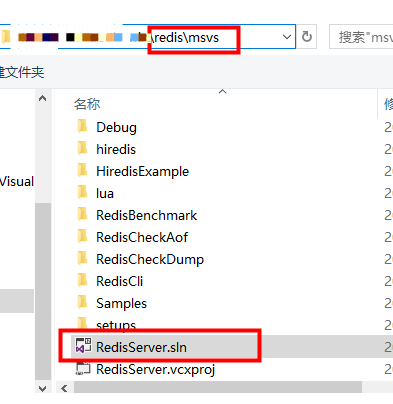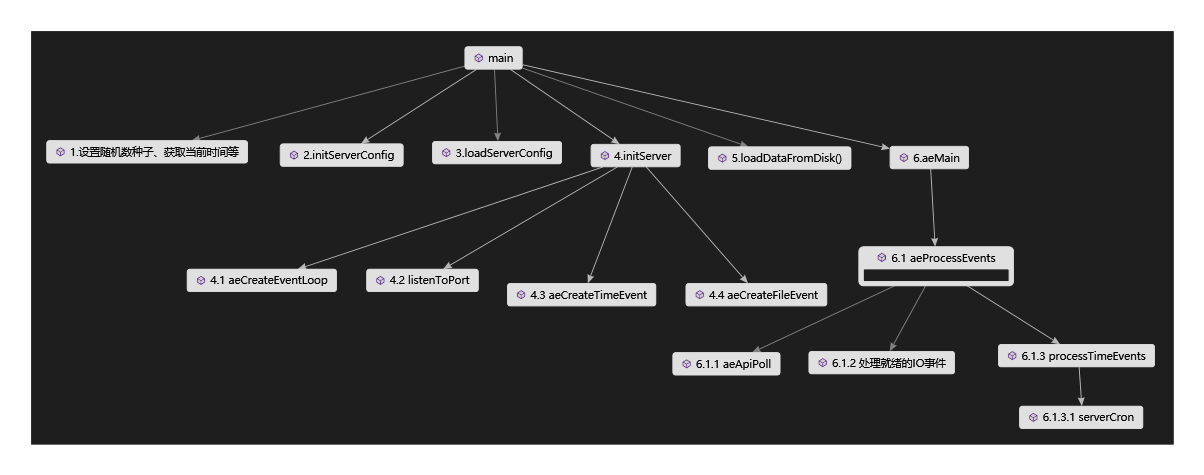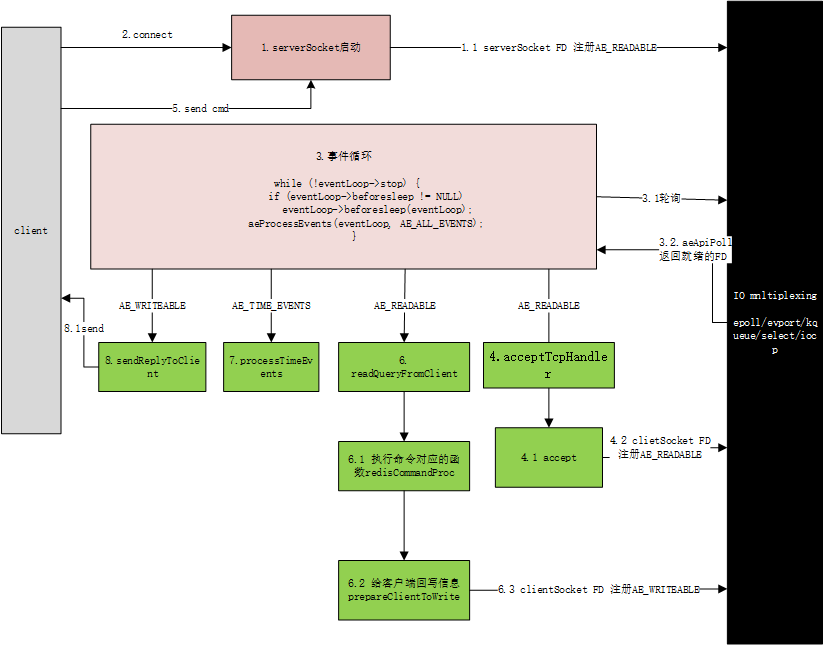redis原始碼學習之工作流程初探
阿新 • • 發佈:2020-07-11
[toc]
## 背景
redis是當下比較流行的KV資料庫之一,是抵禦高併發的一把利器,本著知其然還要知其所以然的目的,我決定花一點時間來研究其原始碼,希望最後能向自己解釋清楚“redis為什麼這麼快”這個疑惑,第一篇主要介紹環境搭建和redis工作流程初探,後期會陸續獻上其他有意思的章節。
## 環境準備
我自己的電腦是win10系統,所以我會準備一套適合windows系統的環境來供自己學習,這樣方便除錯分析。
### 下載redis原始碼
redis本身是不支援windows系統的,但是微軟的工程師針對windows平臺做了支援,原始碼放在了github上,有需要的可以自己去下載,我這裡下載的是v2.8.9這個tag的原始碼,下載地址[https://github.com/microsoftarchive/redis]()。這裡扯個題外話,學習一個開源軟體的時候不要一上來就下載最新版本的原始碼看,經過的迭代太多程式碼量就上來了,對於新手來說容易暈,先下一個早期的穩定版本瞭解其體系結構和工作流程,等待熟悉了以後再循序漸進。
### 下載Visual Studio
其他軟體我沒嘗試過,這個是官方推薦的ide,一定一定一定下載 Visual Studio 2013 update5這個版本的,否則編譯的時候各種報錯,下載地址
[http://download.microsoft.com/download/9/3/E/93EA27FF-DB02-4822-8771-DCA0238957E9/vs2013.5_ult_chs.iso]()。這裡再扯個題外話,我剛開始下載的是最新版本的Visual Studio,結果編譯的時候各種報錯,然後就去網路上一頓查一頓試,折騰半天還是沒好,最後下載了 Visual Studio 2013 update5這個版本,結果一把就成功,有些牛角尖一定得鑽,但是有些牛角尖不值得鑽。
### Visual Studio開啟redis原始碼
按照下圖方式開啟下載的redis原始碼



c程式的入口是main方法,redis main方法的位置在redis.c檔案中,下面我們通過main方法來逐步瞭解redis的工作流程。
## 啟動過程分析
跟著main方法順序看下去,大概有以下幾個關鍵步驟(略過了sentinel相關邏輯):
1.設定隨機數種子、獲取當前時間等;
2.初始化服務配置資訊,設定預設值(initServerConfig);
3.解析配置檔案(loadServerConfig);
4.初始化server物件(initServer);
4.1建立eventLoop物件;
4.2建立serverSocket,監聽埠;
4.3新增定時事件到eventLoop物件中;
4.4將serverSocket檔案描述符新增到監視集中,這裡藉助IO多路複用框架的能力(windows平臺使用IOCP,其他平臺使用select、epoll、evport等);
5.從磁碟載入資料到記憶體中(loadDataFromDisk);
6.執行事件迴圈邏輯(aeMain),這是redis真正揮灑汗水的地方,下一節會單獨講述這塊內容。
### 呼叫關係圖

## 事件迴圈分析
我們都知道redis是單執行緒執行客戶端命令的,那究竟是怎樣一種設計才能支援高併發的讀寫呢。
### 工作模型
1.server啟動,建立serverSocket監聽埠,將serverSocket對應的FD(檔案描述符)簡稱為FD-Server新增到IO多路複用框架的監視集當中,註冊AE_READABLE事件(可讀),關聯的事件處理器是acceptTcpHandler;
2.client連線server;
3.事件迴圈開始輪詢IO多路複用框架介面aeApiPoll,會得到就緒的FD,執行對應的事件處理器;
4.由第3步事件迴圈觸發FD-Server AE_READABLE事件對應的事件處理器acceptTcpHandler;
4.1呼叫accept獲得clientSocket對應的FD簡稱為FD-Client;
4.2將FD-Client新增到IO多路複用框架的監視集當中,註冊AE_READABLE事件(可讀),關聯的事件處理器是readQueryFromClient;
5.client傳送redis命令;
6.由第3步事件迴圈觸發FD-Clien AE_READABLE事件對應的事件處理器readQueryFromClient;
6.1解析客戶端發來的redis命令,找到命令對應的redisCommandProc(命令對應的處理函式);
6.2執行redisCommandProc;
6.3prepareClientToWrite準備回寫響應資訊,為FD-Client註冊AE_WRITEABLE事件(可寫),關聯的事件處理器是sendReplyToClient;
7.執行redis中的定時任務;
8.由第3步事件迴圈觸發FD-Clien AE_WRITEABLE事件對應的事件處理器sendReplyToClient,傳送響應內容給client;

### 程式碼分析
server啟動,建立serverSocket並註冊AE_READABLE事件,設定事件處理器為acceptTcpHandler
```
void initServer() {
//省略部分程式碼
//初始化eventLoop物件,eventLoop物件裡面儲存了所有的事件
server.el = aeCreateEventLoop(server.maxclients+REDIS_EVENTLOOP_FDSET_INCR);
//建立serverSocket,監聽埠
if (server.port != 0 &&
listenToPort(server.port,server.ipfd,&server.ipfd_count) == REDIS_ERR)
exit(1);
//新增定時任務到eventLoop中
if(aeCreateTimeEvent(server.el, 1, serverCron, NULL, NULL) == AE_ERR) {
}
//將serverSocket對應的檔案描述符新增到監視集中,關聯的事件處理器是acceptTcpHandler
for (j = 0; j < server.ipfd_count; j++) {
if (aeCreateFileEvent(server.el, server.ipfd[j], AE_READABLE,
acceptTcpHandler,NULL) == AE_ERR)
}
}
```
acceptTcpHandler當有連線過來的時候被觸發,呼叫accept得到client socket對應的FD,並將FD新增到監視集中,關聯的事件處理器是readQueryFromClient
```
void acceptTcpHandler(aeEventLoop *el, int fd, void *privdata, int mask) {
int cport, cfd;
//呼叫accept獲得clientSocket對應的FD
cfd = anetTcpAccept(server.neterr, fd, cip, sizeof(cip), &cport);
//將clientSocket對應的FD新增到監視集中
acceptCommonHandler(cfd,0);
}
static void acceptCommonHandler(int fd, int flags) {
redisClient *c;
//呼叫createClient新增
if ((c = createClient(fd)) == NULL) {
}
}
redisClient *createClient(int fd) {
redisClient *c = zmalloc(sizeof(redisClient));
if (fd != -1) {
anetNonBlock(NULL,fd);
anetEnableTcpNoDelay(NULL,fd);
if (server.tcpkeepalive)
anetKeepAlive(NULL,fd,server.tcpkeepalive);
//將fd新增到監視集中,關聯的事件處理器是readQueryFromClient
if (aeCreateFileEvent(server.el,fd,AE_READABLE,
readQueryFromClient, c) == AE_ERR)
{
}
}
}
```
aeMain就是跑一個迴圈,一直去呼叫aeProcessEvents
```
void aeMain(aeEventLoop *eventLoop) {
eventLoop->stop = 0;
while (!eventLoop->stop) {
if (eventLoop->beforesleep != NULL)
eventLoop->beforesleep(eventLoop);
aeProcessEvents(eventLoop, AE_ALL_EVENTS);
}
}
```
aeProcessEvents會呼叫aeApiPoll方法來獲得就緒的檔案描述符,然後執行檔案描述符關聯的的事件處理器
```
int aeProcessEvents(aeEventLoop *eventLoop, int flags)
{
int processed = 0, numevents;
#ifdef _WIN32
if (ServiceStopIssued() == TRUE)
aeStop(eventLoop);
#endif
/* Nothing to do? return ASAP */
if (!(flags & AE_TIME_EVENTS) && !(flags & AE_FILE_EVENTS)) return 0;
/* Note that we want call select() even if there are no
* file events to process as long as we want to process time
* events, in order to sleep until the next time event is ready
* to fire. */
if (eventLoop->maxfd != -1 ||
((flags & AE_TIME_EVENTS) && !(flags & AE_DONT_WAIT))) {
int j;
aeTimeEvent *shortest = NULL;
struct timeval tv, *tvp;
if (flags & AE_TIME_EVENTS && !(flags & AE_DONT_WAIT))
shortest = aeSearchNearestTimer(eventLoop);
if (shortest) {
long now_sec, now_ms;
/* Calculate the time missing for the nearest
* timer to fire. */
aeGetTime(&now_sec, &now_ms);
tvp = &tv;
tvp->tv_sec = shortest->when_sec - now_sec;
if (shortest->when_ms < now_ms) {
tvp->tv_usec = ((shortest->when_ms+1000) - now_ms)*1000;
tvp->tv_sec --;
} else {
tvp->tv_usec = (shortest->when_ms - now_ms)*1000;
}
if (tvp->tv_sec < 0) tvp->tv_sec = 0;
if (tvp->tv_usec < 0) tvp->tv_usec = 0;
} else {
/* If we have to check for events but need to return
* ASAP because of AE_DONT_WAIT we need to set the timeout
* to zero */
if (flags & AE_DONT_WAIT) {
tv.tv_sec = tv.tv_usec = 0;
tvp = &tv;
} else {
/* Otherwise we can block */
tvp = NULL; /* wait forever */
}
}
numevents = aeApiPoll(eventLoop, tvp);
for (j = 0; j < numevents; j++) {
aeFileEvent *fe;
int mask = eventLoop->fired[j].mask;
int fd = eventLoop->fired[j].fd;
int rfired = 0;
fe = &eventLoop->events[eventLoop->fired[j].fd];
/* note the fe->mask & mask & ... code: maybe an already processed
* event removed an element that fired and we still didn't
* processed, so we check if the event is still valid. */
if (fe->mask & mask & AE_READABLE) {
rfired = 1;
fe->rfileProc(eventLoop,fd,fe->clientData,mask);
}
if (fe->mask & mask & AE_WRITABLE) {
if (!rfired || fe->wfileProc != fe->rfileProc)
fe->wfileProc(eventLoop,fd,fe->clientData,mask);
}
processed++;
}
}
/* Check time events */
if (flags & AE_TIME_EVENTS)
processed += processTimeEvents(eventLoop);//處理延遲任務
return processed; /* return the number of processed file/time events */
}
```
###動畫演示
做了一個動畫幫助理解工作過程(redis啟動之後使用命令列telnet到6379埠,然後執行keys *命令,最終拿到結果)

##網路模組
###IO多路複用
這部分內容網路上精彩的內容太多,這裡把我認為比較經典的一些內容貼出來供大家品讀(建議從上往下順序閱讀)
[The C10K problem](http://www.kegel.com/c10k.html)
[socket阻塞非阻塞等頭疼問題解釋](https://www.cnblogs.com/junneyang/p/6126635.html)
[LINUX – IO MULTIPLEXING – SELECT VS POLL VS EPOLL](https://devarea.com/linux-io-multiplexing-select-vs-poll-vs-epoll/#.XvB2n8gzaks)
[poll vs select vs event-based](https://daniel.haxx.se/docs/poll-vs-select.html)
[redis事件驅動](https://redis.io/topics/internals-ev
